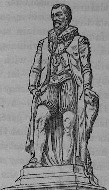 Hugh Myddleton, Upper St, by John Thomas.
Hugh Myddleton, Upper St, by John Thomas.
 Hugh Myddleton, Upper St, by John Thomas.
Hugh Myddleton, Upper St, by John Thomas.
A pleasant walk can be made along Upper Street, from Angel Islington through to Highbury and Islington tube stations, both on the Victoria tube line, with a 5 minute extension down Holloway Rd. Lots of elegant, pricy restaurants near the beginning, moving down market at the other end. On the walk can be seen several examples of architectural sculpture, including substantial work by M. L. Watson and F. E. Schenck, and a Boer War memorial with exquisite figure by Bertram Mackennal.
Starting at Angel, a few minutes stroll along Upper Street, past some antique shops on the right hand side, leads to a small green space at the junction with Essex Road, a remnant of Islington Green, where stands a well-sited statue of Hugh Myddleton. The statue, by John Thomas, dated 1868 (posthumous - it was unfinished at the time of the sculptor's death), is in weathered white stone. He is shown standing in an easy posture, pantalooned, cloaked, and with plans in one hand. He is raised on a high plinth with two flanking cherubic figures with urns, to pour water into shell-like receptacles. Myddleton was responsible for bringing fresh water to the north of the city.
On the left hand side of road, next to no 76, by the entrance of St Alban’s Place, we may note a little domed building with on top a much-painted figure of a girl, a stocky, conventionalized Greek figure in light drapes bearing a lamp on her head, and with her other hand on her ample hip.
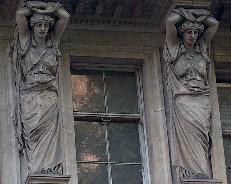 Caryatids, on the Old Post Office, Islington.
Caryatids, on the Old Post Office, Islington.
Further up Upper Street, on the left hand side the former Northern District Post Office, with conventional heraldic coat of arms in pediment, and below a balcony, held up by 4 caryatids; pleasing classical girls with their arms crossed above their heads, and nice drapery. Lots more caryatids on this page. Then a little way on, a church on the right, alas the ambiance of the churchyard lost by recent landscaping and removal of the monuments. On the small pediment, a modest depiction of the adoration of the shepherds, including a variety of sheep and goats, plus camel.
Almost opposite, on the left is Almeida St, with at its entrance on the corner to the right, a good terra cotta effort with a stubby tower. At a high level, a repeated design of pairs of grotesques, little heads, and satyrs in high relief, with steles and further Panlike figures sitting cross-legged on the pillars, and a roundel on the corner showing a portrait of a wild deity with bulrushes in his hair. A couple more roundels lower down with further portraits.
Now here is what we have come to find. Down Almeida St, a few paces past the Greek Almeida Theatre, on the right is a little green space called Pattishill Gardens, Napier Terrace. You need to go in to spot the sculpted frieze on one wall – it is an excellent thing by M. L. Watson, and as the plaque explains, date from 1842, created as an adornment for the long gone Moxhay’s Hall of Commerce, Leadenhall Street. The title is The Benefits of Commerce, and the frieze shows a series of groups of appropriate classically draped figures. Rather reminiscent of a Flaxman drawing, and sadly, rather worn.
Back to Upper St, and a few minutes takes us to Highbury and Islington station. Crossing over Holloway Road, down a short side road at the entrance to the open space of Highbury Fields, is a memorial to the dead of Islington in the Boer War, dated 1905. This consists of an excellent bronze Victory as a girlish figure raising a wreath, with the lightest art nouveau mannerisms, a Roman lamp perhaps in her other hand. She stands on a plinth with two cannons near the base. One of the best ideal figures by the sculptor Bertram Mackennal. (Other examples of allegorical figures of Victory on this page.)
Mackennal's Boer War Victory as she is, and was first conceived.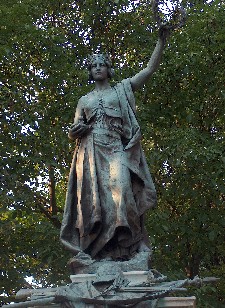
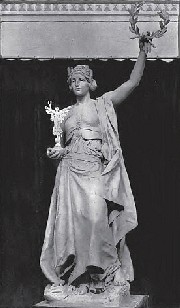
Back to the station, a few minutes walk down Holloway Road is the Public Free Library (Islington Central Library), an ornate building by the architect H. T. Hare, dating from 1906. Three ideal heads, very art nouveau, are over the windows, and two stone statues, of Bacon and Spenser, adorn the side of the building towards the main road. These are all by the sculptor F. E. Schenck. He also did the sculptural decorations on 37 Harley Street, close to Cavendish Square. Library buildings are not uncommonly decorated with sculpture; for a more modest example in South London, see the page on Durning Library, Kennington.
The walk ends back at Highbury and Islington Station on the Victoria Line, or a little further continuing along Holloway Road, rather bleakly, is Holloway Road Station on the Piccadilly Line. A walk to the north along Holloway Road leads to the church of St John the Evangelist, Holloway (Archway).
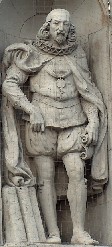 Figure of Bacon from Schenck's Islington Library scheme.
Figure of Bacon from Schenck's Islington Library scheme.
London sculpture // Sculpture pages
Visits to this page from 13 Mar 2014: 7,579